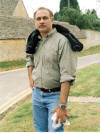|
|
the-south-asian.com July / August 2006 |
|
|||
|
August/September Contents
Sufis - wisdom against 50
years of mountain Heritage cities:
Cotton - the fibre of
|
|
||||
|
Page 2 of 6
HARAPPA – REMAINS OF THE INDUS CIVILIZATION [ 3500 B.C.] by Salman Minhas
First published June 2005
On the road: Lahore to Harappa The road from Lahore to the ancient town of Harappa is now a broad 4–lane highway. It winds its way through the densely populated rich agricultural plains [also called "do-aaba" – 2 waters / rivers in Persian ; 'Mesopotamia' also is by origin a Greek name (mesos `middle' and 'potamos' - 'river' so `land between the rivers').] . Textile & other factories between the two rivers of Ravi and the Sutlej and old orange & mango fruit orchards of the Mitchell’s fruit farms [Renala Khurd] and the Army Orchards [Okara] line the main highway. Despite the inclusion of MohenjoDaro in the UNESCO World Heritage sites, Harappa still has to await its turn to be included in the roster of the ancient civilization sites worth preserving. The Multan Highway bypasses the agricultural town of Okara and after reaching Sahiwal [ 150 kilometers from Lahore], one turns right at a Gas Station after the Sahiwal bypass. About 3 kilometers later one crosses the Harappa Railway Station [ built out of old Harappa bricks ] and then turn right after crossing the railway line. After about 5 kilometers through richly cultivated agricultural land, one crosses a medium sized canal as one travels another 5 kilometers towards the Harappa museum with its quiet rest house [motel] and the nearby ancient Harappa city ruins site. The original railway track [started in 1860] goes straight thorough these small towns enroute Lahore to Multan. Harappa lies on the left bank of the Ravi River. Night driving is slow as one contends with the trucks over-loaded with dried chaff from the rice and wheat harvest. The huge tractor-trailer [ also called "trawlaas" in the local idiom – a take –off on the word "trawlers" or "trolley" ] loaded with sugarcane straw make night driving unsafe.
Water & Civilization: The ancient and now defunct river Saraswati [now reduced to a seasonal stream called the Ghaggar] has a fascinating geological story. Etymologically, Saraswati means `abundance of lakes (saras)'. Geologically, the entire Saraswati river bed, and the arm of the Arabian sea (formerly spanning into saline Ranns of Kutch) into which the river fell are on an earth-quake belt. The recent earthquake in Gujarat and the destruction of the town of Bhuj once again highlights the area’s volatile and active Tectonic movements. These tectonic movements pushed up the Aravalli hills, in northern Rajasthan. They also changed the drainage pattern of the Northwest Punjab rivers drastically. Saraswati lost her major tributaries, Yamuna and Sutlej. Sutlej turned west and joined Beas-Sindhu system, and Yamuna migrated east to join Ganga. Yamuna also pirated Saraswati's sources. Eventually only floodwaters flowed through her vast channels. As late as the 16th century AD, the floodwaters of Sutlej flowed down Saraswati. Even today, Ghaggar; a puny seasonal river, occupies some parts of Saraswati's dry beds.
Prof. Ahmad Hasan Dani writes (Ed. Indus Civilization -- New Perspectives, Quaid-i-Azam University, Islamabad, 1981, pp.3- 12): `To him (John Marshall) goes the credit of coining the term The Indus Civilization. But his geographic horizon no longer holds good ... . The wide-spread nature of the Indus Civilization throughout Panjab and Sind had already expanded the meaning of the original term. Still later in the post-1947 period the Indus Civilization sites have been discovered in large number outside the present Indus region right up to the very borders of Yamuna in the north-east (Alamgirpur on the Hindon, a tributary of the Yamuna about 30 miles north of Delhi), along the dried-up bed of the river Ghaggar in northern part of Rajasthan, and in Gujrat right upto the mouths of Narbada and Tapti rivers'. The ancient ruins of the town of Harappa, lie next to the old bed of the Ravi river, which are now cultivated using a mixture of the old Harappan technologies of the bullock cart, and the diesel engine tractors, but with very much the same staple crops as in 3000 B.C. [barley, lentils , wheat, dates. The first mention [ pre-1890] of the Indus Valley civilization is when a British Army deserter, James Lewis, posing as an American engineer named Charles Masson, recorded the presence of "a vast ruined city with the remains of a ruinous brick castle" and fragments of walls and buildings in the town of Harappa, in Punjab. In the 1856, Two English engineers, John and William Brunton were building a railway line from Karachi to Lahore. Whilst looking for ballast for the railway they came across several mounds, which were supposed to be the ruins of an ancient city, built entirely of bricks. This city was Harappa. According to Mr Asim Dogar [curator at Harappa Museum], not only did the British Railway engineers use the bricks as railway track ballast, but also almost all the railway stations including Harappa [see picture] Railway Station between Lahore and Multan were built using the Harappan site bricks. Similarly, the town people of current day Harappa have also used these bricks freely in the past for building their houses. Virtually half of the Harappa site bricks vanished due to this reason.
|
|||||
|
Copyright © 2000 - 2006 [the-south-asian.com]. Intellectual Property. All rights reserved. |
|||||



